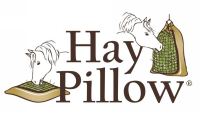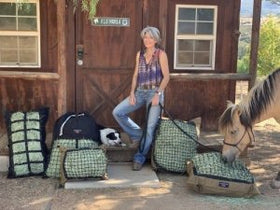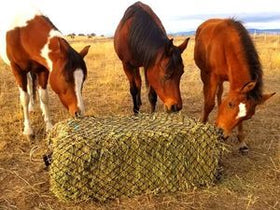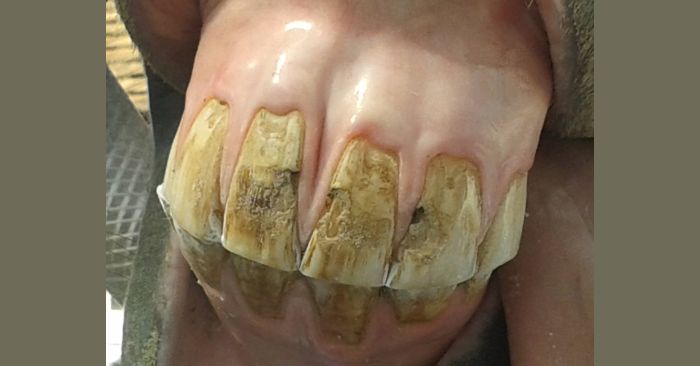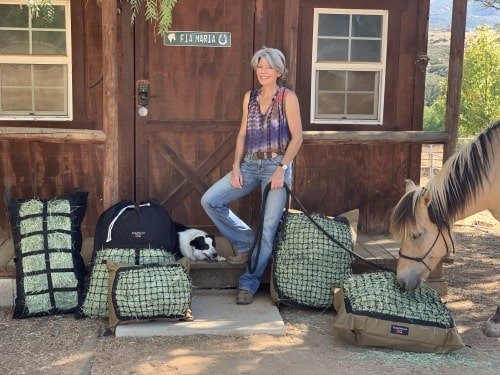Horse Slow Feeder Safety Tips
Slow feeders and slow feed hay nets offer numerous benefits for our beloved horses, donkeys, mules and their barnyard buddies. As with any device, there are potential risks (including, but not limited to, damage to teeth, gums and lips and entanglement). The vast majority of incidents are preventable. Read on to learn general safety measures to follow when choosing and using your slow feeders.
Slow feeder safety is becoming a hot topic and rightfully so. As a slow feed expert, I have learned that safety is determined by the choices you make:
- The type of slow feeder device and its surface material
- The opening/mesh size
- How you use the feeder
The vast majority of incidents stem from unintentional pilot error. You can eliminate or greatly reduce the possibility of injury or entanglement with the following tips.
Ensure Your Horse Uses His Lips
First and foremost, your primary objective should be to ensure your horse has the ability to use his lips to calmly gather hay and easily grasp the ends with his teeth to extract it – similar to grazing behavior.
In nature, grazing and browsing animals gather forage with their lips, grasp and break it off with their incisors and chew with their molars.
If an individual is required to scrape teeth across an abrasive surface to extract hay, the probability of damage to lips, gums or teeth is almost certain. If your horse is currently scraping his teeth across a slow feeder, inspect his lips, teeth and gums immediately.

3 Primary Reasons Your Horse Cannot Use His Lips
The following three factors that force them to scrape their teeth across the surface to extract hay are the most common reasons for damage to lips, teeth and gums - regardless of the slow feed device.- Mesh/opening size that is too small – Too small of an opening can exceed your horse’s patience level or ability. Patience level always trumps ability when choosing a mesh/opening size. It may seem counter-intuitive, but smaller is not always better when it comes to slow feeding.
- Filling the feeder/net too tight – This compacts and flattens the ends of the hay (instead of allowing it to protrude through the openings) regardless of the mesh/opening size or slow feed device.
- Inserting intact flakes of alfalfa or grass hay that is compressed or densely baled – To ensure the ends protrude for gathering with the lips, the flakes need to be completely broken apart.

Tip - One Size Does Not Fit All
Each horse varies in patience level and ability. You may have a herd of 9 that successfully uses a particular slow feeder design and mesh/opening size, yet add a new herd member and he may experience damage to his mouth in a day.
The most appropriate slow feeder type and opening size is determined on an individual basis.
When offering slow fed forage to 2 or more individuals in the same enclosure, choose a mesh/opening size to accommodate the least adept or patient individual.
Usage Tips for Common Slow Feed Surfaces
Rigid surfaces such as metal grates and hard plastic holes are nonconforming and flatten the ends of hay. To ensure your horse can use his lips successfully, use loose fill and choose an opening large enough so that his lips can reach into the opening unobstructed.
Webbing mesh (1” wide web) reduces the overall surface area to extract hay, thereby flattening the ends of the hay. If you use a large enough opening size to allow your horse to manipulate hay with his lips and easily extract with his teeth, it can be a great option.
Netting has the ability to conform to the hay while providing a much larger surface area to gather hay from. If loaded properly (not too full), your horse can manipulate the hay with his lips and teeth (no scraping) allowing the ends to protrude. Again, key is that the mesh size does not exceed your horse’s patience level.

Slow feeders I made and experimented with during my 4-year experimental journey.
During my 4-year experimental journey (2008-2012) of creating a slow feeder that met my needs, I ultimately determined netting was the most effective for slow feeding. However, both hard-sided and webbing mesh devices are successful for many. We are not discouraging their use as long as they are effective and cause no harm.
Entanglement Possibilities & Considerations
Including, but not limited to:
- If your horse is shod or barefoot with large chipped flares, netting and webbing mesh should be out of strike range and never used on the ground. The back of the shoe or chipped feet can become caught in the mesh.
- Be mindful of the height of hard sided ground feeders to avoid a shod hoof being placed inside it and the shoe potentially becoming caught in the openings.
- Never use a mesh/opening size larger than the hoof.
- The top of hanging hay nets and bags should be hung directly to the attachment site without slack to avoid being wrapped around legs or necks.
- If hanging from an elevated attachment site:
- Attach a rope to the attachment site (eye hook, tree branch, rafters or stall grates).
- Slide a piece of PVC pipe over the entire length of the rope. Ensure the ends are not sharp.
- Attach a swivel clip at the bottom.
- Hang your hay bag or net from the swivel clip as shown in the photos below.

- Straps used on hanging hay bags should be used with caution - a head or leg can become ensnared above or below the bag between the strap attachments.
- Long wolf teeth, a missing front tooth or poorly maintained incisors (jagged) can become caught in any slow feed device. Competent routine dental care should be provided at all ages whether you’re using a slow feeder or not.
- Excess drawstrings should always be knotted/secured to avoid being wrapped around legs or necks.
Tips When Shopping for a New Slow Feeder
- Read the entire product page to get all pertinent information.
- If your horse is shod, determine if it is a safe option when used as directed.
- Choose the largest opening/mesh size initially. You can always experiment with a smaller opening once there is no evidence of teeth being scraped across the surface, frustration or injury to lips, gums and teeth. See our tips for changing to smaller mesh sizes in Slow Feeding – Tips & Techniques.
- Not all slow feed devices are appropriate for all weather conditions. Keep in mind you may need more than one - or more than one type – of feeder for under cover and outside use during inclement weather. See our tips for slow feed options by weather condition/environment.
- Call the manufacturer with any questions or concerns about their product.
- Read the instructions that come with your slow feeder in their entirety before use.
Bottom Line
Many of us make the switch to slow feeding with good intentions – whether it's to introduce the benefits of trickle feeding, minimize hay waste, or to manage weight.
Please don’t sacrifice your beloved companion’s physical and/or mental health in an attempt to slow his rate of consumption to the point of injury or frustration.
Helpful Resources
- Slow Feeding - Tips & Techniques
- 9 Benefits of Slow Feeding Horses - Get Slow Feed Savvy
- 7 Slow Feed Do’s and Don’ts for Horses
- Slow Feed Solutions by Enclosure Type & Weather Condition
- Choosing a Mesh Size for Slow Feeding
- How I Chose the Best Slow Feeder for My Horse
- Study - How Hay Feeder Height Affects Jaw, Neck & Back Posture in Horses
- Sand Colic - The Surprising (Simple) Cure & Prevention
